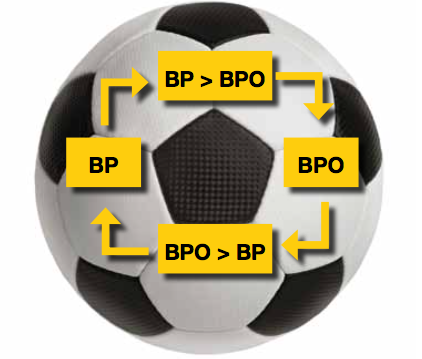|
1. you saw and/or heard something within the game; |
Signals from the eyes and ears processed by |
PERCEPTION |
|
2. you analysed the situation and/or the communication you received |
The information was processed and a decision made by THE BRAIN |
DECISION |
|
3. you did something |
THE BRAIN sent a signal to the muscles |
EXECUTION |
The player Perceives what is happening in the game, processes the information based on the Objectives and Tasks of football, Decides what should be done, and then Executes the action.
The three stages of Perception, Decision and Execution (PDE) can be quite clearly distinguished, but are so closely inter-dependent that they cannot be separated.
To design EFFECTIVE practice activities the coach must have a solid understanding of the underlying theory and process of decision making. This is where some misinformation/interpretation is prevalent.
The technical jargon for decision making is “perceptual-cognitive skill”. This defines a process that all players are constantly repeating throughout the course of a match. This process involves a player…
- using the perceptual system (usually visual component) to detect what is happening on the field
- cognitively processing that information to derive meaning from what they see
- deciding on the best option
That “best option” is manifested by a motor skill such as kicking/throwing/handballing the ball (in the case of being in possession and deciding on the best passing option) or locomotion (ie moving into best position without the ball).
In terms of the perceptual aspect, clearly this requires visual functioning, scanning, awareness etc to operate most effectively. However it is not the training/development of these things per se that develop a players decision making ability. More critical is that the things players are perceiving, or “cues”, must be the same or very similar to what is seen in a match (therefore we are primarily concerned with realistic positioning and movement of the ball and other players).
Over time players learn to associate these “cues” with certain actions that will prove most effective for a particular situation (ie passing the ball over, or through, the defense when an attacker has made a run into space behind the defense). You may have seen the term “Perception-Action Coupling” used to describe this – the cues players perceive become strongly coupled with a decision to execute a certain action(s).
Therefore, decision making capacities are developed by constant exposure to perceiving cues and taking action. Through trial and error players learn to associate, or strongly couple, cues with appropriate action.






